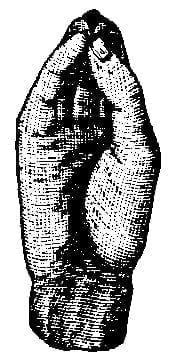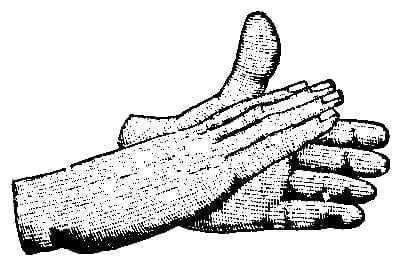Good
The hand held horizontally, back upward, describes with the arm a horizontal curve outward. (Long.) This is like the Eurasian motion of benediction, but may more suggestively be compared with several of the signs for yes, and in opposition to several of those for bad and no, showing the idea of acceptance or selection of objects presented, instead of their rejection.
Place the right hand horizontally in front of the breast and move it forward. (Wied.) This description is essentially the same as the one I furnished. (Mandan and Hidatsa I.) I stated, however, that the hand was moved outward (i.e., to the right). I do not remember seeing it moved directly forward. In making the motion as I have described it the hand would have to go both outward and forward. (Matthews.) The left arm is elevated and the hand held in position (W). The arm and hand are thus extended from the body on a level with the chest; the elbow being slightly bent, the arm resembles a bent bow. The right arm is bent and the right hand, in position (W), sweeps smoothly over the left arm from the biceps muscle over the ends of the fingers. This sign and Wied’s are noticeably similar. The difference is, the Oto sign uses the left arm in conjunction and both more to the left. The conception is of something that easily passes; smoothness, evenness, etc., in both. (Boteler.)
Wave the hand from the mouth, extending the thumb from the index and closing the other three fingers. This sign also means I know. (Burton.)
(1) Right-hand fingers pointing to the left placed on a level with mouth, thumb inward; (2) suddenly moved with curve outward so as to present palm to person addressed. (Cheyenne II.)
Pass the open right hand, palm downward, from the heart, twenty-four inches horizontally forward and to the right through an arc of about 90°. (Dakota IV.) “Heart easy or smooth.”
Another: Gently strike the chest two or three times over the heart with the radial side of the right hand, the fingers partly flexed and pointing downward. An Arapaho sign. (Dakota IV.)
Place the flat right hand, palm down, thumb touching the breast, then move it forward and slightly upward and to the right. (Arapaho II; Cheyenne V; Ojibwa V; Dakota VI, VII, VIII; Kaiowa I; Comanche III; Apache II; Wichita II.)
Pass the flat hand, palm down, from the breast forward and in a slight curve to the right. (Dakota VI; Hidatsa I; Ankara I.)
The extended right hand, palm downward, thumb backward, fingers pointing to the left, is held nearly or quite in contact with the body about on a level with the stomach; it is then carried outward to the right a foot or two with a rapid sweep, in which the forearm is moved but not necessarily the humerus. (Mandan and Hidatsa I.)
Move right hand, palm down, over the blanket, right and left, several times. (Omaha I.)
Another: Hit the blanket, first on the right, then on the left, palm down, several times. (Omaha I.)
Another: Point at the object with the right forefinger, shaking it a little up and down, the other fingers being closed. (Omaha I.)
Another: Same as preceding, but with the hand open, the thumb crooked under and touching the forefinger; hand held at an angle of 45° while shaking a little back and forth. (Omaha I.)
Another: Hold the closed hands together, thumbs up; separate by turning the wrists down, and move the fists a little apart; then reverse movements till back to first position. (Omaha I.)
Another: Hold the left hand with back toward the ground, fingers and thumb apart, and curved; hold the right hand opposite it, palm down, hands about six inches apart; shake the hands held thus, up and down, keeping them the same distance apart. (Omaha I.)
Another: Hold the hands with the palms in, thumbs up, move hands right and left, keeping them about six inches apart. (Omaha I.)
Another: Look at the right hand, first on the back, then on the palm, then on the back again. (Omaha I.)
The flat right hand, palm down, is moved forward and upward, starting at a point about twelve inches before the breast. (Wyandot I.)
Hold the flat right hand forward and slightly outward from the shoulder, palm either upward or downward, and pass it edgewise horizontally to the right and left. This sign was made when no personality was involved. The same gesturer when claiming for himself the character of goodness made the following: Rapidly pat the breast with the flat right hand. (Pima and Papago I.)
Throw right hand from front to side, fingers extended and palm down, forearm horizontal. (Sahaptin I.)
Make an inclination of the body forward, moving at the same time both hands forward from the breast, open, with the palm upward, and gradually lowering them. This is also used for glad, pleased. (Iroquois I.)
Bring both hands to the front, arms extended, palms outward; elevate them upward and slightly forward; the face meanwhile expressive of wonder. (Comanche I.)
Bring the hand opposite the breast, a little below, hand extended, palm downward (W), and let it move off in a horizontal direction. If it be very good, this may be repeated. If comparatively good, repeat it more violently. (Comanche I.)
Hold the right hand palm down, pointing to the left, and placed horizontally before the breast, then raise it several times slightly. Good and glad. (Kutchin I.)
Deaf-mute natural signs:
Smack the lips. (Ballard.)
Close the hand while the thumb is up, and nod the head and smile as if to approve of something good. (Hasenstab.)
Point the forefinger to the mouth and move the lips with a pleased look as if tasting sweet fruit. (Larson.)
Use the sign for handsome by drawing the outstretched palm of the right hand down over the right cheek; at the same time nod the head as if to say “yes.” (Ziegler.)
Deaf-mute signs:
Some of the Indian signs appear to be connected with a pleasant taste in the month, as is the sign of the French and American deaf-mutes, waving thence the hand, either with or without touching the lips, back upward, with fingers straight and joined, in a forward and downward curve. They make nearly the same gesture with hand sidewise for general assent: “Very well!”
The conventional sign for good, given in the illustration to the report of the Ohio Institution for the education of the deaf and dumb, is: The right hand raised forward and closed, except the thumb, which is extended upward, held vertically, its nail being toward the body; this is in opposition to the sign for bad in the same illustration, the one being merely the exhibition of the thumb toward and the other of the little finger away from the body. They are English signs, the traditional conception being acceptance and rejection respectively.
Italian signs:
The fingers gathered on the mouth, kissed and stretched out and spread, intimate a dainty morsel. The open hand stretched out horizontally, and gently shaken, intimates that a thing is so-so, not good and not bad. (Butler.) Compare also the Neapolitan sign given by De Jorio, see Fig. 62, p. 286, supra. Cardinal Wiseman gives as the Italian sign for good “the hand thrown upwards and the head back with a prolonged ah!” Loc. cit., p. 543.
- – Heart is.
Strike with right hand on the heart and make the sign for Good from the heart outward. (Cheyenne II.)
Touch the left breast over the heart two or three times with the ends of the fingers of the right hand; then make the sign for Good. (Dakota IV.)
Place the fingers of the flat right hand over the breast, then make the sign for Good. (Dakota VII.)
Move hand to position in front of breast, fingers extended, palm downward (W), then with quick movement throw hand forward and to the side to a point 12 or 15 inches from body, hand same as in first position. (Sahaptin I.)
For further remarks on the signs for good, see page 286.
Habitation, including House, Lodge, Tipi, Wigwam
– – House
The hand half open and the forefinger extended and separated; then raise the hand upward and give it a half turn, as if screwing something. (Dunbar.)
Cross the ends of the extended fingers of the two hands, the hands to be nearly at right angle, radial side up, palms inward and backward, thumbs in palms. Represents the logs at the end of a log house. (Creel; Dakota IV.)
Partly fold the hands; the fingers extended in imitation of the corner of an ordinary log house. (Arapaho I.)
Both hands outspread near each other, elevated to front of face; suddenly separated, turned at right angles, palms facing; brought down at right angles, suddenly stopped. Representing square form of a house. (Cheyenne II.)
The fingers of both hands extended and slightly separated, then those of the right are placed into the several spaces between those of the left, the tips extending to about the first joints. (Absaroka I.) “From the arrangement of the logs in a log building.”
Both hands extended, fingers spread, place those of the right into the spaces between those of the left, then move the hands in this position a short distance upward. (Wyandot I.) “Arrangement of logs and elevation.”

Both hands are held edgewise before the body, palms facing, spread the fingers, and place those of one hand into the spaces between those of the other, so that the tips of each protrude about an inch beyond. (Hidatsa I; Kaiowa I; Arikara I; Comanche III; Apache II; Wichita II.) “The arrangement of logs in a frontier house.” Fig. 253. In connection with this sign compare the pictograph, Fig. 204, page 379, supra. In ordinary conversation the sign for white man’s house is often dropped, using instead the generic term employed for lodge, and this in turn is often abbreviated, as by the Kaiowas, Comanches, Wichitas, and others, by merely placing the tips of the extended forefingers together, leaving the other fingers and thumbs closed, with the wrists about three or four inches apart.
Both hands held pointing forward, edges down, fingers extended and slightly separated, then place the fingers of one hand into the spaces between the fingers of the other, allowing the tips of the fingers of either hand to protrude as far as the first joint, or near it. (Shoshoni and Banak I.) “From the appearance of a corner of a log houseprotruding and alternate layers of logs.”
Fingers of both hands interlaced at right angles several times; then the sign for Lodge. (Kutchin I.)
Deaf-mute natural signs:
Draw the outlines of a house in the air with hands tip to tip at a right angle. (Ballard.)
Put the open hands together toward the face, forming a right angle with the arms. (Larson.)
- – , Stone; Fort.
Strike the back of the right fist against the palm of the left hand, the left palm backward, the fist upright (“idea of resistance or strength”); then with both hands opened, relaxed, horizontal, and palms backward, place the ends of the right fingers behind and against the ends of the left; then separate them, and moving them backward, each through a semicircle, bring their bases together. The latter sign is also that of the Arapahos for house. An inclosure. (Dakota IV.) The first part of this sign is that for stone.
- – Lodge, Tipi, Wigwam
The two hands are reared together in the form of the roof of a house, the ends of the fingers upward. (Long.)
Place the opened thumb and forefinger of each hand opposite each other, as if to make a circle, but leaving between them a small interval; afterward move them from above downward simultaneously (which is the sign for village); then elevate the finger to indicate the numberone. (Wied.) Probably he refers to an earthen lodge. I think that the sign I have given you is nearly the same with all the Upper Missouri Indians. (Matthews.)
Place the fingers of both hands ridge-fashion before the breast. (Burton.)
Indicate outlines (an inverted V, thus ^), with the forefingers touching or crossed at the tips, the other fingers closed. (Creel; Arapaho I.)
Both hands open, fingers upward, tips touching, brought downward, and at same time separated to describe outline of a cone, suddenly stopped. (Cheyenne II.)
Both hands approximated, held forward horizontally, fingers joined and slightly arched, backs upward, withdraw them in a sideward and downward direction, each hand moving to its corresponding side, thus combinedly describing a hemisphere. Carry up the right and, with its index pointing downward indicate a spiral line rising upward from the center of the previously formed arch. (Ojibwa V.) “From the dome-shaped form of the wigwam, and the smoke rising from the opening in the roof.”
Both hands flat and extended, placing the tips of the fingers of one against those of the other, leaving the palms or wrists about four inches apart. (Absaroka I; Wyandot I; Shoshoni and Banak I.) “From its exterior outline.”
Both hands carried to the front of the breast and placed V-shaped, inverted, thus ^, with the palms, looking toward each other, edge of fingers outward, thumbs inward. (Dakota I.) “From the outline of the tipi.”
With the hands nearly upright, palms inward, cross the ends of the extended forefingers, the right one either in front or behind the left, or lay the ends together; resting the ends of the thumbs together side by side, the other fingers to be nearly closed, and resting against each other, palms inward. Represents the tipi poles and the profile of the tipi. (Dakota IV.)
Place the tips of the fingers of both hands together in front of the breast, with the wrists some distance apart. (Dakota V.) Fig. 254.

Fingers of both hands extended and separated; then interlace them so that the tips of the fingers of one hand protrude beyond the backs of those of the opposing one; hold the hands in front of the breast, pointing upward, leaving the wrists about six inches apart. (Dakota VII, VIII;Hidatsa I; Ponka II; Arikara I; Pani I.)
The extended hands, with finger tips upward and touching, the palms facing one another, and the wrists about two inches apart, are held before the chest. (Mandan and Hidatsa I.)
Place the tip of the index against the tip of the forefinger of the left hand, the remaining fingers and thumbs closed, before the chest, leaving the wrists about six inches apart. (Kaiowa I; Comanche III; Apache II; Wichita II.) “Outline of lodge.” This is an abbreviated sign, and care must be taken to distinguish it from to meet, in which the fingers are brought from their respective sides instead of upward to form the gesture.
Another: Place the tips of the fingers of the flat extended hands together before the breast, leaving the wrists about six inches apart. (Kaiowa I; Comanche III; Apache II; Wichita II.)
Another: Both hands flat and extended, fingers slightly separated; then place the fingers of the right hand between the fingers of the left as far as the second joints, so that the fingers of one hand protrude about an inch beyond those of the other; the wrists must be held about six inches apart. (Kaiowa I; Comanche III; Apache II; Wichita II.) “Outline of Indian lodge and crossing of tent-poles above the covering.” Fig. 255.

Fig. 256 represents a Sahaptin sign given to the writer by a gentleman long familiar with the northwestern tribes of Indians. The conception is the same union of the lodge poles at the top, shown in several other signs, differently executed.

Place the tips of the spread fingers of both hands against one another pointing upward before the body, leaving a space of from four to six inches between the wrists. Fig. 257. The fingers are sometimes bent so as to more nearly represent the outline of a house and roof. Fig. 258. This, however, is accidental. (Pai-Ute I.)”Represents the boughs and branches used in the construction of a Pai-Ute ‘wik-i-up.'”


Place the tips of the two flat hands together before the body, leaving a space of about six inches between the wrists. (Ute I.) “Outline of the shape of the lodge.”
Left hand and right hand put together in shape of sloping shelter (Kutchin I.) Fig. 259.

– – Great Council House.
Place both flat and extended hands in front of the shoulders, pointing forward, palms facing; then pass them straight upward and slightly inward near the termination of the gesture. This appears to combine the gestures for much, large, and lodge. (Arikara I.)
– – , Coming or going out of a.
Same as the sign for entering a lodge, only the fingers of the right hand point obliquely upward after passing under the left hand. (Dakota I.) “Coming out from under cover.”
Hold the open left hand a foot or eighteen inches in front of the breast, palm downward or backward, fingers pointing toward the right and pass the right, back upward, with index extended, or all of the fingers extended, and pointing forward, about eighteen inches forward underneath the left through an arc from near the mouth. Some at the same time move the left hand toward the breast. (Dakota IV.)
– – , Entering a.
The left hand is held with the back upward, and the right hand also with the back up is passed in a curvilinear direction down under the other, so as to rub against its palm, then up on the other side of it. The left hand here represents the low door of the skin lodge and the right the man stooping down to pass in, (Long.)
Pass the flat right hand in short curves under the left, which is held a short distance forward. (Wied.) I have described the same sign. It is not necessary to pass the hand more than once. By saying curves, he seems to imply many passes. If the hand is passed more than once it means repetition of the act. (Matthews; McChesney.) The conception is of the stooping to pass through the low entrance, which is often covered by a flap of skin, sometimes stretched on a frame, and which must be shoved aside, and the subsequent rising when the entrance has been accomplished. A distinction is reported by a correspondent as follows: “If the intention is to speak of a person entering the gesturer’s own lodge, the right hand is passed under the left and toward the body, near which the left hand is held; if of a person entering the lodge of another, the left hand is held further from the body and the right is passed under it and outward. In both cases both hands are slightly curved and compressed.” As no such distinction is reported by others it may be an individual invention or peculiarity.
A gliding movement of the extended hand, fingers joined, backs up, downward, then ascending, indicative of the stooping and resumption of the upright position in entering the same. (Arapaho I.)
(1) Sign for Lodge, the left hand being still in position used in making sign for Lodge; (2) forefinger and thumb of right hand brought to a point and thrust through the outline of an imaginary lodge represented by the left hand. (Cheyenne II.)
First make the sign for Lodge, then place the left hand, horizontal and slightly arched, before the body, and pass the right hand with extended index underneath the leftforward and slightly upward beyond it. (Absaroka I; Dakota V; Shoshoni and Banak I; Wyandot I.)
Left hand (W), ends of fingers toward the right, stationary in front of the left breast; pass the right hand directly and quickly out from the breast under the stationary left hand, ending with the extended fingers of the right hand pointing outward and slightly downward, joined, palm downward flat, horizontal (W). (Dakota I.) “Gone under; covered.”
Hold the open left hand a foot or eighteen inches in front of the breast, palm downward or backward, fingers pointing toward the right, and pass the right hand, palm upward, fingers bent sidewise and pointing backward, from before backward underneath it, through a curve until near the mouth. Some at the same time move the left hand a little forward. (Dakota IV.)
The left hand, palm downward, finger-tips forward, either quite extended or with the fingers slightly bent, is held before the body. Then the right hand nearly or quite extended, palm downward, finger-tips near the left thumb, and pointing toward it, is passed transversely under the left hand and one to four inches below it. The fingers of the right hand point slightly upward when the motion is completed. This sign usually, but not invariably, refers to entering a house. (Mandan and Hidatsa I.)
Place the slightly curved left hand, palm down, before the breast, pointing to the right, then pass the flat right hand, palm down, in a short curve forward, under and upward beyond the left. (Ute I.) “Evidently from the manner in which a person is obliged to stoop in entering an ordinary Indian lodge.”
